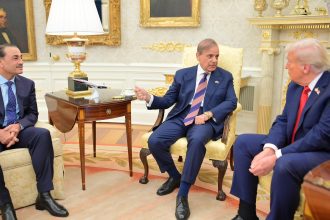On April 13, 2025, the global trade landscape faced new tensions as US President Donald Trump announced increased trade tariffs on Pakistani products, later temporarily suspended.
The development, reported by various sources, including The Express Tribune and Dawn.com, has raised alarms in Pakistan, particularly in its export sector. The Pakistan Institute of Development Economics (Pide) has issued a policy note titled “Impact of Unilateral Tariff Increase by the United States on Pakistani Exports,” conducted by Dr Muhammad Zeshan, Dr Shujaat Farooq, and Dr Usman Qadir, highlighting the potential devastation to Pakistan’s economy.
The proposed tariffs include a 29% reciprocal tariff, which, when added to the existing 8.6% Most Favoured Nation (MFN) tariff, could result in a total duty of 37.6% on Pakistani exports to the US. As noted in The Express Tribune, this steep increase is projected to cause a 20-25% decline in exports, translating into an annual loss of $1.1-1.4 billion. In fiscal year 2024, Pakistan exported $5.3 billion worth of goods to the US, making it the largest single-country export market, with textiles and apparel accounting for a significant share, as per USTR. This loss could accumulate to $4.22 billion over five years if the full burden is passed to consumers. However, partial absorption by exporters might mitigate immediate impacts to $0.6-0.4 billion in 2024.
Sectoral and Economic Effects: A Deeper Dive
The textile sector, already facing tariffs as high as 17%, would bear the brunt, with Pide warning of severe erosion in price competitiveness. CASS notes that this could allow regional competitors like India and Bangladesh to capture market share. Major exporters such as Nishat Mills and Interloop may be forced to reduce production, threatening over 500,000 jobs, a figure supported by Dawn.com. Beyond textiles, non-textile exports like leather, rice, surgical instruments, and sports goods saw strong growth. IT exports exceeding $1 billion in 2024 to the US are also vulnerable, as per The Express Tribune. The economic consequences extend to macroeconomic instability and reduced foreign exchange earnings, potentially destabilizing Pakistan’s broader economy.
Pide recommends immediate diplomatic engagement to highlight mutual costs, such as the $181 million worth of cotton the US exported to Pakistan in 2024, which is now at risk, per the policy note. Reducing tariffs on select US imports like machinery, scrap metal, and petroleum could create a negotiation room. Encouraging Pakistani firms to use more US-origin inputs like cotton and yarn might help maintain value chains and seek tariff exemptions. These strategies aim to preserve long-standing trade relations, as suggested in CASS.
Long-term Diversification: Expanding Horizons
For long-term resilience, diversification is pivotal. Pide urges exploring emerging markets such as the European Union, China, ASEAN nations, Africa, and the Middle East, offering growth potential in IT, halal food, processed foods, and sports goods, as noted in The Express Tribune. To facilitate this shift, Pakistan must focus on reducing energy and logistics costs, streamlining regulations, and promoting innovation and technology adoption. A comprehensive US trade strategy emphasizing technology, agriculture, energy, and value-added manufacturing synergies is also essential, aligning with Dawn.com‘s call for strategic policy reforms.
As per the Observatory of Economic Complexity, the proposed US tariffs exceed the World Trade Organisation’s (WTO) bound tariff ceiling of 3.4%, potentially violating multilateral trade rules. Legal recourse through the WTO is an option, but Pakistan’s limited fiscal resources may hinder such efforts, as noted in the Pide report. More critically, these tariffs ignore the interconnected nature of global trade. This is exemplified by the US-Pakistan textile loop, where American cotton supplies Pakistani mills, which export finished garments back to the US, a point emphasized in CASS. Disrupting this value chain benefits neither country, highlighting the need for cooperative solutions.
In conclusion, while the road ahead is challenging, it presents an opportunity for Pakistan to recalibrate and strengthen its export framework. With timely diplomacy, strategic policy reforms, and bold diversification efforts, Pakistan can not only withstand this external shock but also emerge as a more competitive and resilient player in the global economy, as advocated by Dawn.com. The path forward requires a balanced approach, leveraging both short-term tactical moves and long-term strategic vision to navigate the complexities of global trade dynamics.
Table: Key Statistics on US-Pakistan Trade and Tariff Impact
| Metric | Value |
|---|---|
| Pakistan’s 2024 exports to US | $5.3 billion |
| Proposed total tariff duty | 37.6% |
| Projected annual export loss | $1.1-1.4 billion |
| Potential job losses | Over 500,000 |
| US cotton exports to Pakistan | $181 million (2024) |






